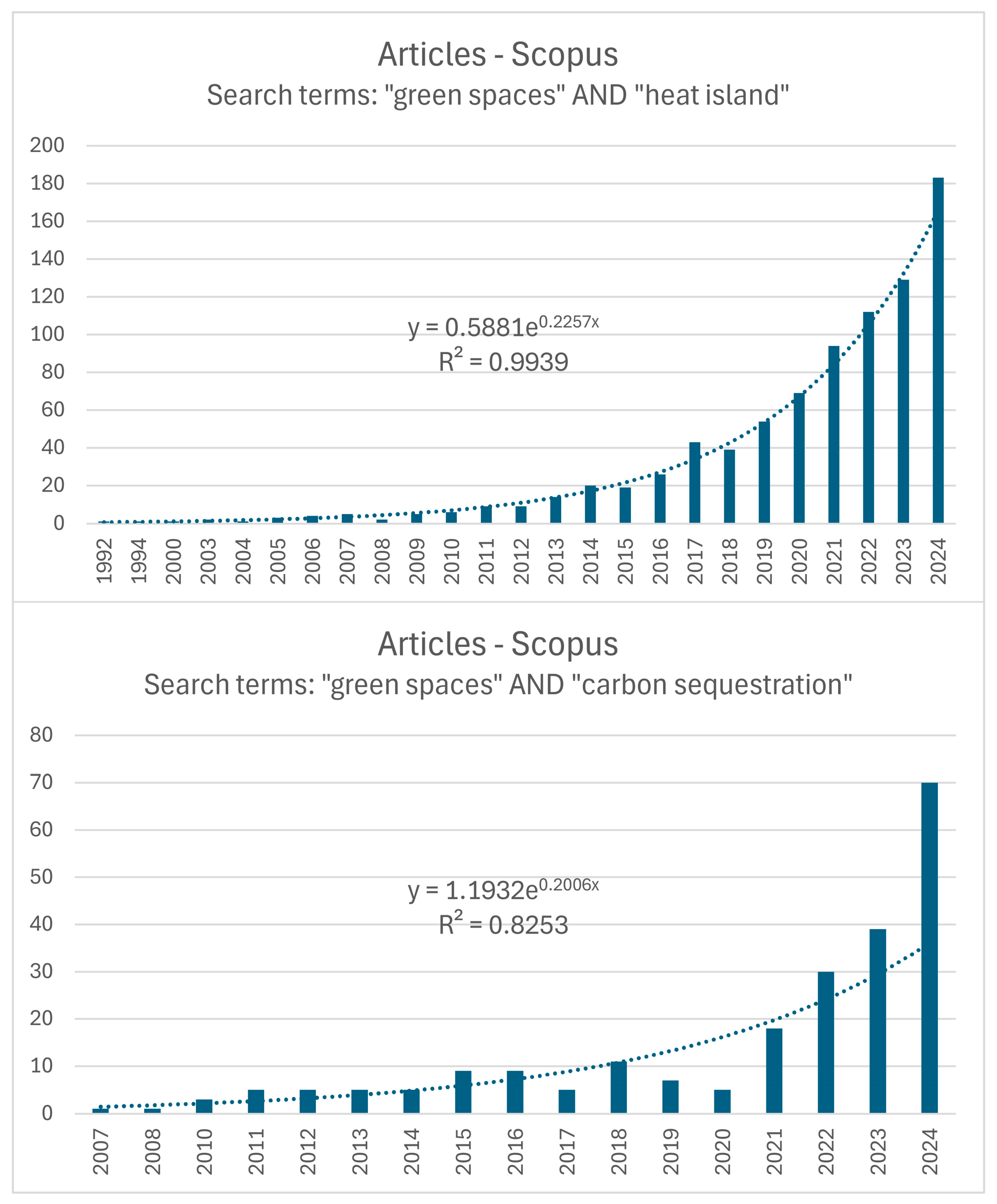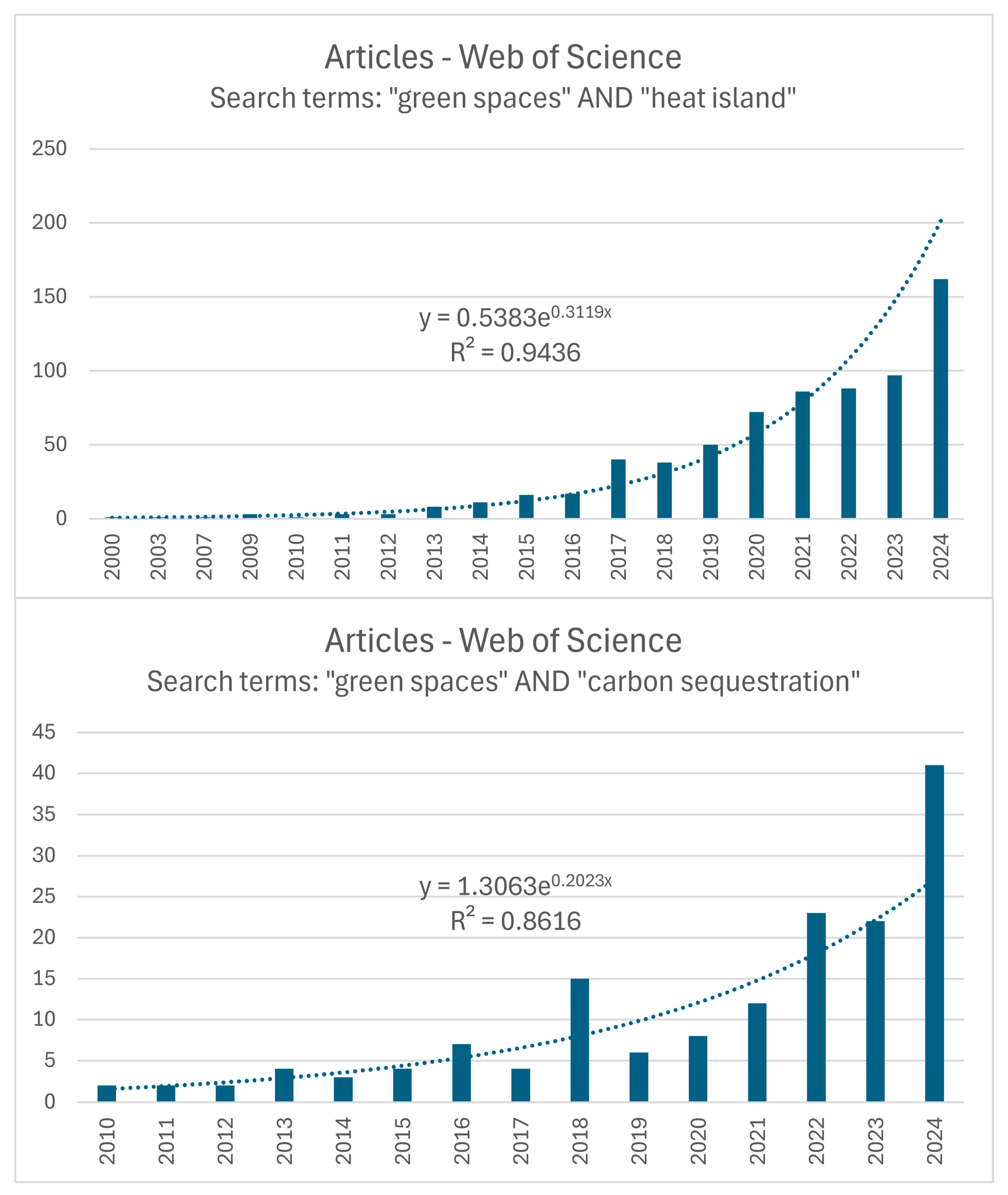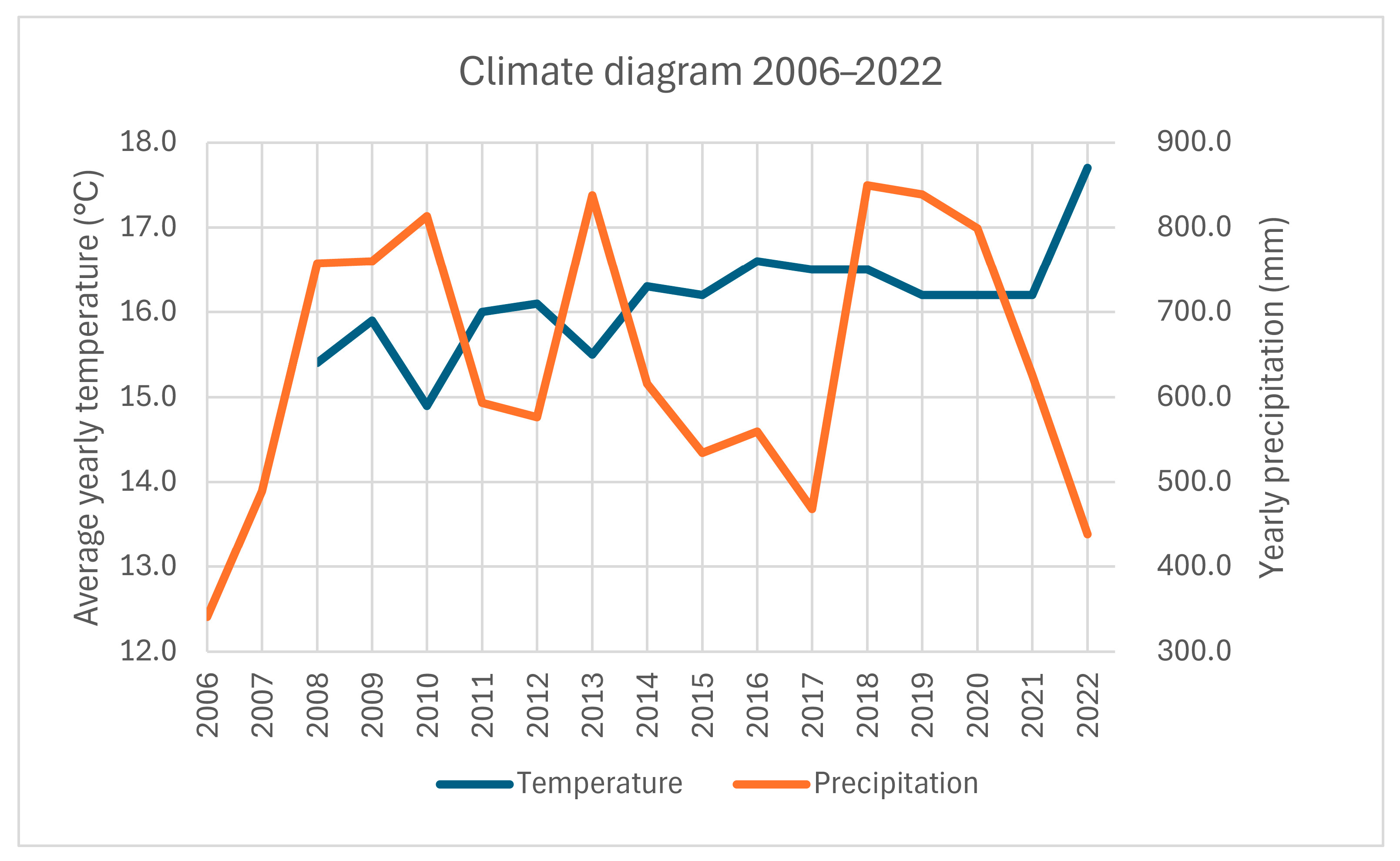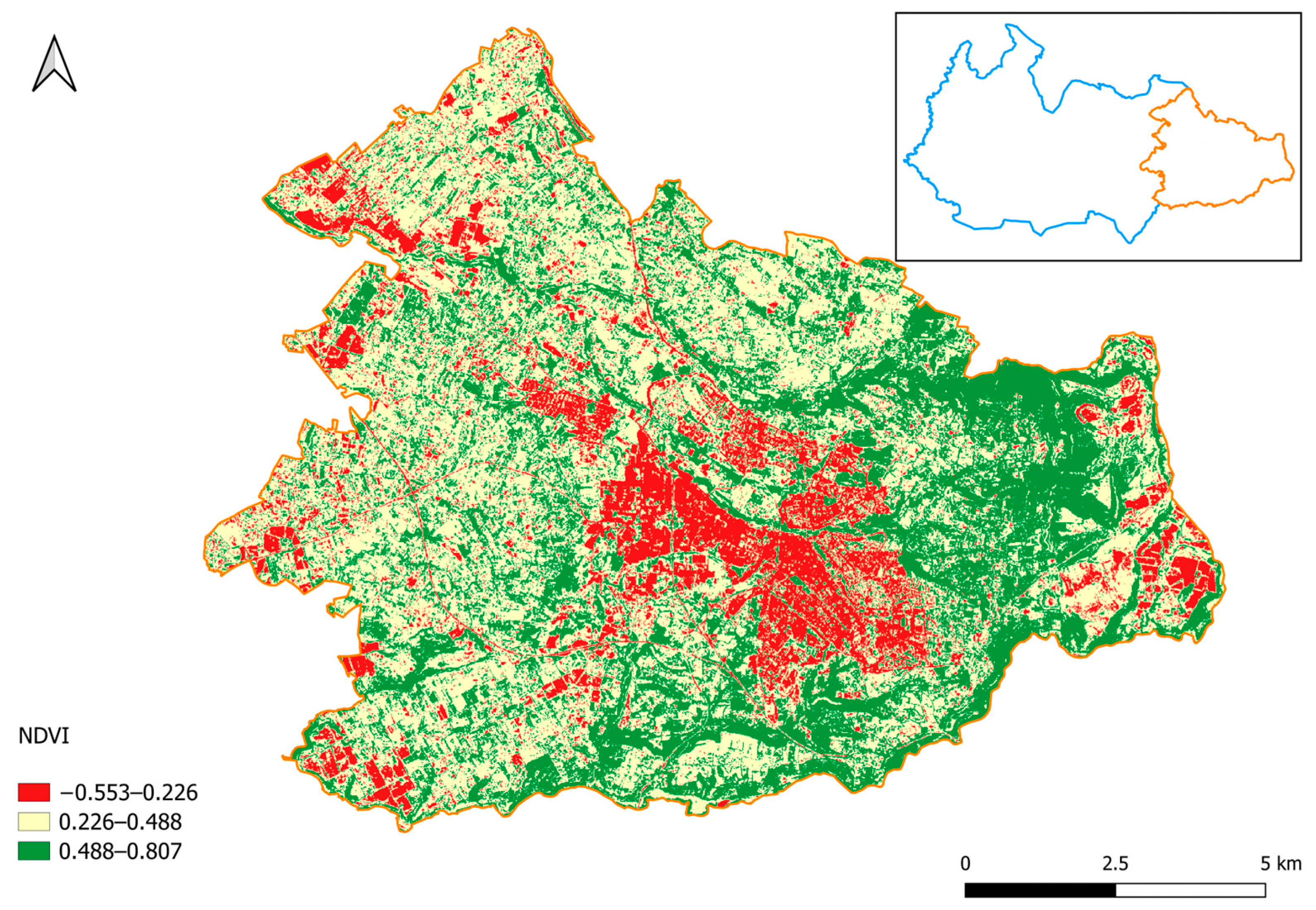Urban Green Spaces and Climate Changes: Assessing Ecosystem Services for the Municipality of Sassari (Italy)
Abstract
1. Introduction
2. Green Spaces for Climate Change Adaptation and Mitigation
3. Materials and Methods
3.1. Case Study: The Municipality of Sassari (Italy)
3.2. Assessing the Ecosystem Services
3.2.1. Greenhouse Gas Sequestration by Terrestrial Ecosystems—ES1
3.2.2. Mitigating the Heat Island Effect Through Vegetation—ES2
4. Results
4.1. Greenhouse Gas Sequestration by Terrestrial Ecosystems
4.2. Mitigating the Heat Island Effect Through Vegetation
5. Discussion
6. Conclusions
Author Contributions
Funding
Data Availability Statement
Conflicts of Interest
Abbreviations
| CICES | Common International Classification of Ecosystem Services |
| ESs | Ecosystem Services |
| EDiss | Ecosystem Disservices |
| e.g., | ‘exempli gratia’ means ‘for example’ |
| GUP | Green Urban Plan |
| HIMI | Heat Island Mitigation Index |
| i.e., | ‘id est’ means ‘that is’ |
| kNDVI | Kernel Normalized Difference Vegetation Index |
| NDVI | Normalized Difference Vegetation Index |
| MCPUGA | Municipal code for the protection of urban green areas |
| MMP | Municipal Master Plan |
| UGS | Urban green spaces |
| UHI | Urban Heat Island |
| PCI | Park Cool Island |
Appendix A



| Zone Code | Label | Sub-Zone Code | Description |
|---|---|---|---|
| E | Agricultural areas | E5.a | Marginal agricultural areas that require adequate environmental conditions. These areas can also be used for low-impact agro-zootechnical and silvo-pastoral activities. |
| E5.c | Marginal agricultural areas that require adequate environmental conditions. Areas of low agricultural importance, which are relevant to soil protection and conservation. | ||
| G | Areas for general services | G2 | Urban parks, sports and leisure facilities. |
| H | Protection areas | H2.8 | Areas of environmental and landscape value (urban valleys). |
| H2.9 | Areas of environmental and landscape value (woods and forests). | ||
| H4 | Green areas, which are mainly adjacent to urban and extra-urban public roads. The construction of buildings is forbidden. | ||
| S | Areas for equipped public spaces | S3 | Areas defined in the green plan and regulation such as simple green areas, neighborhood parks, etc. |
| S3/p | ‘Building credit’ areas. ‘Building credit’ means building capacity recognized after implementing measures concerning the improvement of urban, landscape, and environmental quality. | ||
| SD3 e SD4 | Areas for equipped public spaces in industrial areas. |
References
- Ma, Y.; Yang, J. A Review of Methods for Quantifying Urban Ecosystem Services. Landsc. Urban Plan. 2025, 253. [Google Scholar] [CrossRef]
- Bayulken, B.; Huisingh, D.; Fisher, P.M.J. How Are Nature Based Solutions Helping in the Greening of Cities in the Context of Crises Such as Climate Change and Pandemics? A Comprehensive Review. J. Clean. Prod. 2021, 288, 125569. [Google Scholar] [CrossRef]
- Hussain, M.; Butt, A.R.; Uzma, F.; Ahmed, R.; Irshad, S.; Rehman, A.; Yousaf, B. A Comprehensive Review of Climate Change Impacts, Adaptation, and Mitigation on Environmental and Natural Calamities in Pakistan. Environ. Monit. Assess. 2020, 192, 48. [Google Scholar] [CrossRef]
- Khan, I.; Lei, H.; Shah, A.A.; Khan, I.; Muhammad, I. Climate Change Impact Assessment, Flood Management, and Mitigation Strategies in Pakistan for Sustainable Future. Environ. Sci. Pollut. Res. 2021, 28, 29720–29731. [Google Scholar] [CrossRef]
- Wu, T.; Barrett, J. Coastal Land Use Management Methodologies under Pressure from Climate Change and Population Growth. Environ. Manag. 2022, 70, 827–839. [Google Scholar] [CrossRef]
- Tabucanon, A.S.; Kurisu, K.; Hanaki, K. Assessment and Mitigation of Tangible Flood Damages Driven by Climate Change in a Tropical City: Hat Yai Municipality, Southern Thailand. Sci. Total Environ. 2021, 789, 147983. [Google Scholar] [CrossRef]
- Yang, K.; Zhang, J.; Cui, D.; Ma, Y.; Ye, Y.; He, X.; Yang, Z.; Cheng, M.; Zhang, Y. Multi-Scale Study of the Synergy between Human Activities and Climate Change on Urban Heat Islands in China. Sustain. Cities Soc. 2025, 125, 106341. [Google Scholar] [CrossRef]
- Laino, E.; Iglesias, G. Scientometric Review of Climate-Change Extreme Impacts on Coastal Cities. Ocean. Coast. Manag. 2023, 242, 106709. [Google Scholar] [CrossRef]
- Frame, D.J.; Rosier, S.M.; Noy, I.; Harrington, L.J.; Carey-Smith, T.; Sparrow, S.N.; Stone, D.A.; Dean, S.M. Climate Change Attribution and the Economic Costs of Extreme Weather Events: A Study on Damages from Extreme Rainfall and Drought. Clim. Change 2020, 162, 781–797. [Google Scholar] [CrossRef]
- Gérardeaux, E.; Giner, M.; Ramanantsoanirina, A.; Dusserre, J. Positive Effects of Climate Change on Rice in Madagascar. Agron. Sustain. Dev. 2012, 32, 619–627. [Google Scholar] [CrossRef]
- Gérardeaux, E.; Sultan, B.; Palaï, O.; Guiziou, C.; Oettli, P.; Naudin, K. Positive Effect of Climate Change on Cotton in 2050 by CO2 Enrichment and Conservation Agriculture in Cameroon. Agron. Sustain. Dev. 2013, 33, 485–495. [Google Scholar] [CrossRef]
- Bolan, S.; Padhye, L.P.; Jasemizad, T.; Govarthanan, M.; Karmegam, N.; Wijesekara, H.; Amarasiri, D.; Hou, D.; Zhou, P.; Biswal, B.K.; et al. Impacts of Climate Change on the Fate of Contaminants through Extreme Weather Events. Sci. Total Environ. 2024, 909, 168388. [Google Scholar] [CrossRef]
- Kabisch, N.; Remahne, F.; Ilsemann, C.; Fricke, L. The Urban Heat Island under Extreme Heat Conditions: A Case Study of Hannover, Germany. Sci. Rep. 2023, 13, 23017. [Google Scholar] [CrossRef]
- Ebi, K.L.; Capon, A.; Berry, P.; Broderick, C.; de Dear, R.; Havenith, G.; Honda, Y.; Kovats, R.S.; Ma, W.; Malik, A.; et al. Hot Weather and Heat Extremes: Health Risks. Lancet 2021, 398, 698–708. [Google Scholar] [CrossRef]
- Carter, J.G.; Cavan, G.; Connelly, A.; Guy, S.; Handley, J.; Kazmierczak, A. Climate Change and the City: Building Capacity for Urban Adaptation. Prog. Plan. 2015, 95, 1–66. [Google Scholar] [CrossRef]
- Yang, L.; Qian, F.; Song, D.-X.; Zheng, K.-J. Research on Urban Heat-Island Effect. Procedia Eng. 2016, 169, 11–18. [Google Scholar] [CrossRef]
- Chang, J.; Qu, Z.; Xu, R.; Pan, K.; Xu, B.; Min, Y.; Ren, Y.; Yang, G.; Ge, Y. Assessing the Ecosystem Services Provided by Urban Green Spaces along Urban Center-Edge Gradients. Sci. Rep. 2017, 7, 11226. [Google Scholar] [CrossRef]
- Paudel, S.; States, S.L. Urban Green Spaces and Sustainability: Exploring the Ecosystem Services and Disservices of Grassy Lawns versus Floral Meadows. Urban For. Urban Green. 2023, 84, 127932. [Google Scholar] [CrossRef]
- Song, P.; Kim, G.; Mayer, A.; He, R.; Tian, G. Assessing the Ecosystem Services of Various Types of Urban Green Spaces Based on I-Tree Eco. Sustainability 2020, 12, 1630. [Google Scholar] [CrossRef]
- Rodrigues Ferreira Barbosa, V.; Maria Damasceno, R.; Andreotti Dias, M.; Jablinski Castelhano, F.; Llacer Roig, H.; Requia, W.J. Ecosystem Services Provided by Green Areas and Their Implications for Human Health in Brazil. Ecol. Indic. 2024, 161, 111975. [Google Scholar] [CrossRef]
- Mao, Q.; Wang, L.; Guo, Q.; Li, Y.; Liu, M.; Xu, G. Evaluating Cultural Ecosystem Services of Urban Residential Green Spaces From the Perspective of Residents’ Satisfaction with Green Space. Front. Public Health 2020, 8, 226. [Google Scholar] [CrossRef]
- Pinto, L.V.; Inácio, M.; Ferreira, C.S.S.; Ferreira, A.D.; Pereira, P. Ecosystem Services and Well-Being Dimensions Related to Urban Green Spaces—A Systematic Review. Sustain. Cities Soc. 2022, 85, 104072. [Google Scholar] [CrossRef]
- de Vries, S.; Verheij, R.A.; Groenewegen, P.P.; Spreeuwenberg, P. Natural Environments—Healthy Environments? An Exploratory Analysis of the Relationship between Greenspace and Health. Environ. Plan. A 2003, 35, 1717–1731. [Google Scholar] [CrossRef]
- Swanwick, C.; Dunnett, N.; Woolley, H. Nature, Role and Value of Green Space in Towns and Cities: An Overview. Built Environ. 2003, 29, 94–106. [Google Scholar] [CrossRef]
- Urban Task Force. Towards an Urban Renaissance—Final Report of the Urban Task Force; Queen’s Printer and Controller of HMSO—Taylor & Francis e-Library: Abingdon, UK, 2005. [Google Scholar]
- Fuller, R.A.; Irvine, K.N.; Devine-Wright, P.; Warren, P.H.; Gaston, K.J. Psychological Benefits of Greenspace Increase with Biodiversity. Biol. Lett. 2007, 3, 390–394. [Google Scholar] [CrossRef]
- Taylor, L.; Hochuli, D.F. Defining Greenspace: Multiple Uses across Multiple Disciplines. Landsc. Urban Plan. 2017, 158, 25–38. [Google Scholar] [CrossRef]
- Costanza, R.; d’Arge, R.; de Groot, R.; Farber, S.; Grasso, M.; Hannon, B.; Limburg, K.; Naeem, S.; O’Neill, R.V.; Paruelo, J.; et al. The Value of the World’s Ecosystem Services and Natural Capital. Nature 1997, 387, 253–260. [Google Scholar] [CrossRef]
- Bolund, P.; Hunhammar, S. Ecosystem Services in Urban Areas. Ecol. Econ. 1999, 29, 293–301. [Google Scholar] [CrossRef]
- Millennium Ecosystem Assessment. Ecosystems and Human Well-Being: Synthesis; Island Press: Washington, DC, USA, 2005. [Google Scholar]
- Wu, S.; Li, B.V.; Li, S. Classifying Ecosystem Disservices and Valuating Their Effects—A Case Study of Beijing, China. Ecol. Indic. 2021, 129, 107977. [Google Scholar] [CrossRef]
- Shackleton, C.M.; Ruwanza, S.; Sinasson Sanni, G.K.; Bennett, S.; De Lacy, P.; Modipa, R.; Mtati, N.; Sachikonye, M.; Thondhlana, G. Unpacking Pandora’s Box: Understanding and Categorising Ecosystem Disservices for Environmental Management and Human Wellbeing. Ecosystems 2016, 19, 587–600. [Google Scholar] [CrossRef]
- Blanco, J.; Dendoncker, N.; Barnaud, C.; Sirami, C. Ecosystem Disservices Matter: Towards Their Systematic Integration within Ecosystem Service Research and Policy. Ecosyst. Serv. 2019, 36, 100913. [Google Scholar] [CrossRef]
- Garber, M.D.; Benmarhnia, T.; Zhou, W.; Mudu, P.; Rojas-Rueda, D. Greening Urban Areas in Line with Population Density and Ecological Zone Can Reduce Premature Mortality. Commun. Earth Environ. 2024, 5, 650. [Google Scholar] [CrossRef]
- European Parliament and Council Regulation (EU). 2024/1991 of the European Parliament and of the Council of 24 June 2024 on Nature Restoration and Amending Regulation (EU) 2022/869 (Text with EEA Relevance); European Union: Brussels, Belgium, 2024. [Google Scholar]
- European Commission. Communication from the Commission to the European Parliament, the Council, the European Economic and Social Committee and the Committee of the Regions EU Biodiversity Strategy for 2030 Bringing Nature Back into Our Lives; European Commission: Brussels, Belgium, 2020. [Google Scholar]
- Bertoldi, P. Guidebook ‘How to Develop a Sustainable Energy and Climate Action Plan (SECAP)’—Part 1—The SECAP Process, Step-By-Step Towards Low Carbon and Climate Resilient Cities by 2030; EUR 29412 EN; Publications Office of the European Union: Luxembourg, 2018; ISBN 978-92-79-96847-1. [Google Scholar]
- Yao, L.; Li, T.; Xu, M.; Xu, Y. How the Landscape Features of Urban Green Space Impact Seasonal Land Surface Temperatures at a City-Block-Scale: An Urban Heat Island Study in Beijing, China. Urban For. Urban Green. 2020, 52, 126704. [Google Scholar] [CrossRef]
- Reis, C.; Lopes, A. Evaluating the Cooling Potential of Urban Green Spaces to Tackle Urban Climate Change in Lisbon. Sustainability 2019, 11, 2480. [Google Scholar] [CrossRef]
- Gill, S.E.; Handley, J.F.; Ennos, A.R.; Pauleit, S. Adapting Cities for Climate Change: The Role of the Green Infrastructure. Built Environ. 2007, 33, 115–133. [Google Scholar] [CrossRef]
- Zhang, X.; Huang, H.; Tu, K.; Li, R.; Zhang, X.; Wang, P.; Li, Y.; Yang, Q.; Acerman, A.C.; Guo, N.; et al. Effects of Plant Community Structural Characteristics on Carbon Sequestration in Urban Green Spaces. Sci. Rep. 2024, 14, 7382. [Google Scholar] [CrossRef]
- Zhao, D.; Cai, J.; Xu, Y.; Liu, Y.; Yao, M. Carbon Sinks in Urban Public Green Spaces under Carbon Neutrality: A Bibliometric Analysis and Systematic Literature Review. Urban For. Urban Green. 2023, 86, 128037. [Google Scholar] [CrossRef]
- Feng, Y.; Fang, C.; Jia, X.; Song, P.; Zhou, L.; Xu, X.; Wang, K.; He, R.; Guo, N.; Ge, S. Dual Pathways of Carbon Neutrality in Urban Green Spaces: Assessment and Regulatory Strategies. Sustain. Cities Soc. 2025, 125, 106311. [Google Scholar] [CrossRef]
- De Meo, I.; Becagli, C.; Cantiani, G.M.; Casagli, A.; Paletto, A. Citizens’ Use of Public Urban Green Spaces at the Time of the COVID-19 Pandemic in Italy. Urban For. Urban Green. 2022, 77, 127739. [Google Scholar] [CrossRef]
- Giannico, O.V.; Sardone, R.; Bisceglia, L.; Addabbo, F.; Pirotti, F.; Minerba, S.; Mincuzzi, A. The Mortality Impacts of Greening Italy. Nat. Commun. 2024, 15, 10452. [Google Scholar] [CrossRef]
- Sallustio, L.; Perone, A.; Vizzarri, M.; Corona, P.; Fares, S.; Cocozza, C.; Tognetti, R.; Lasserre, B.; Marchetti, M. The Green Side of the Grey: Assessing Greenspaces in Built-up Areas of Italy. Urban For. Urban Green. 2019, 37, 147–153. [Google Scholar] [CrossRef]
- Ottoboni, M.; Pappalardo, S.E.; De Marchi, M.; Ungaro, F. Characterization and Mapping of Public and Private Green Areas in the Municipality of Forlì (NE Italy) Using High-Resolution Images. Land 2023, 12, 660. [Google Scholar] [CrossRef]
- Pantaloni, M.; Marinelli, G.; Santilocchi, R.; Minelli, A.; Neri, D. Sustainable Management Practices for Urban Green Spaces to Support Green Infrastructure: An Italian Case Study. Sustainability 2022, 14, 4243. [Google Scholar] [CrossRef]
- Speak, A.F.; Montagnani, L.; Solly, H.; Wellstein, C.; Zerbe, S. The Impact of Different Tree Planting Strategies on Ecosystem Services and Disservices in the Piazzas of a Northern Italian City. Urban Ecosyst. 2022, 25, 355–366. [Google Scholar] [CrossRef]
- Vidal, D.G.; Dias, R.C.; Teixeira, C.P.; Fernandes, C.O.; Filho, W.L.; Barros, N.; Maia, R.L. Clustering Public Urban Green Spaces through Ecosystem Services Potential: A Typology Proposal for Place-Based Interventions. Environ. Sci. Policy 2022, 132, 262–272. [Google Scholar] [CrossRef]
- Dias, R.C.; Vidal, D.G.; Seixas, P.C.; Maia, R.L. Os espaços verdes e as preocupações com a sustentabilidade nos Planos Diretores Municipais de 3a geração. Cid. Comunidades Territ. 2020, 41. [Google Scholar]
- Lourdes, K.T.; Hamel, P.; Gibbins, C.N.; Sanusi, R.; Azhar, B.; Lechner, A.M. Planning for Green Infrastructure Using Multiple Urban Ecosystem Service Models and Multicriteria Analysis. Landsc. Urban Plan. 2022, 226, 104500. [Google Scholar] [CrossRef]
- European Environment Agency. Common International Classification of Ecosystem Services. Available online: https://cices.eu/ (accessed on 17 June 2025).
- Dong, L.; Wang, Y.; Ai, L.; Cheng, X.; Luo, Y. A Review of Research Methods for Accounting Urban Green Space Carbon Sinks and Exploration of New Approaches. Front. Environ. Sci. 2024, 12, 1350185. [Google Scholar] [CrossRef]
- Wu, Q.; Huang, Y.; Irga, P.; Kumar, P.; Li, W.; Wei, W.; Shon, H.K.; Lei, C.; Zhou, J.L. Synergistic Control of Urban Heat Island and Urban Pollution Island Effects Using Green Infrastructure. J. Environ. Manag. 2024, 370, 122985. [Google Scholar] [CrossRef] [PubMed]
- Speak, A.F.; Salbitano, F. Thermal Comfort and Perceptions of the Ecosystem Services and Disservices of Urban Trees in Florence. Forests 2021, 12, 1387. [Google Scholar] [CrossRef]
- Russo, A.; Escobedo, F.J.; Timilsina, N.; Schmitt, A.O.; Varela, S.; Zerbe, S. Assessing Urban Tree Carbon Storage and Sequestration in Bolzano, Italy. Int. J. Biodivers. Sci. Ecosyst. Serv. Manag. 2014, 10, 54–70. [Google Scholar] [CrossRef]
- Zhang, Y.; Meng, W.; Yun, H.; Xu, W.; Hu, B.; He, M.; Mo, X.; Zhang, L. Is Urban Green Space a Carbon Sink or Source?—A Case Study of China Based on LCA Method. Environ. Impact Assess. Rev. 2022, 94, 106766. [Google Scholar] [CrossRef]
- Cech, R.; Leisch, F.; Zaller, J.G. Pesticide Use and Associated Greenhouse Gas Emissions in Sugar Beet, Apples, and Viticulture in Austria from 2000 to 2019. Agriculture 2022, 12, 879. [Google Scholar] [CrossRef]
- Italian National Institute of Statistics. Temperatura e Precipitazione nei Comuni Capoluogo di Provincia—Anno 2022—Serie Storica 2006–2022; Italian National Institute of Statistics: Rome, Italy, 2024. [Google Scholar]
- Barbato, G.; Mercogliano, P.; Pugliese, A.; Marras, S. Local Climate Change Adaptation Plan for Flooding Risk. Local Climate Model for the Municipality of Sassari [Piano Locale di Adattamento Ai Cambiamenti Climatici per Il Rischio Alluvioni del Comune di Sassari. Profilo Climatico Locale per Il Comune Di Sassari]; Fondazione Centro Euro-Mediterraneo sui Cambiamenti Climatici (CMCC): Lecce, Italy, 2021. [Google Scholar]
- Municipality of Sassari Parco e Giardino. Comune di Sassari; Municipality of Sassari Parco e Giardino: Sassari, Italy, 2024. [Google Scholar]
- Piano Urbanistico Comunale (PUC). Available online: https://www.comune.sassari.it/it/amministrazione/documenti-dati/documenti-tecnici-di-supporto/pianificazione-urbanistica/piano-urbanistico-comunale/index.html (accessed on 12 May 2025).
- Valsecchi, F. La Flora e la Vegetazione; Amministrazione Provinciale di Sassari: Sassari, Italy, 1987. [Google Scholar]
- Municipality of Sassari. Municipal Code for the Protection of Urban Green Areas [Regolamento Comunale per la Tutela del Verde Urbano]; Municipality of Sassari: Sassari, Italy, 2018. [Google Scholar]
- Davidson, M.; Dolnick, F. (Eds.) A Planners Dictionary; American Planning Association: Chicago, IL, USA, 2004; ISBN 978-1-884829-95-3. [Google Scholar]
- Serra, V.; Defraia, S.; Ledda, A.; Calia, G.; Corona, F.; De Montis, A.; Mulas, M. Ecological Network, Ecosystem Services, and Green Infrastructure Planning: A Method for the Metropolitan City of Cagliari, Italy. Netw. Spat. Econ. 2025, 25, 95–120. [Google Scholar] [CrossRef]
- Inventario Nazionale delle Foreste e dei Serbatoi Forestali di Carbonio INFC2005. Available online: https://www.sian.it/inventarioforestale/jsp/dati_carquant_tab.jsp?menu=3 (accessed on 12 May 2025).
- Floris, M. I Servizi Ecosistemici Nella Pianificazione Spaziale Come Strumenti Interpretativi per la Definizione di Tassonomie Territoriali Innovative. PhD Thesis, University of Cagliari, Cagliari, Italy, 2020. [Google Scholar]
- Copernicus Conventional Data Access Hubs|Copernicus. Available online: https://www.copernicus.eu/en/access-data/conventional-data-access-hubs (accessed on 12 May 2025).
- Huang, S.; Tang, L.; Hupy, J.P.; Wang, Y.; Shao, G. A Commentary Review on the Use of Normalized Difference Vegetation Index (NDVI) in the Era of Popular Remote Sensing. J. For. Res. 2021, 32, 1–6. [Google Scholar] [CrossRef]
- Fathollahi, L.; Wu, F.; Melaki, R.; Jamshidi, P.; Sarwar, S. Global Normalized Difference Vegetation Index Forecasting from Air Temperature, Soil Moisture and Precipitation Using a Deep Neural Network. Appl. Comput. Geosci. 2024, 23, 100174. [Google Scholar] [CrossRef]
- Mehta, A.; Shukla, S.; Rakholia, S. Vegetation Change Analysis Using Normalized Difference Vegetation Index and Land Surface Temperature in Greater Gir Landscape. J. Sci. Res. 2021, 65, 1–6. [Google Scholar] [CrossRef]
- Tabacchi, G.; Gasparini, P. L’Inventario Nazionale delle Foreste e dei Serbatoi Forestali di Carbonio. INFC-2005. Secondo Inventario Forestale Nazionale Italiano. Metodi e Risultati. Con CD-ROM; Edagricole Calderini: Milan, Italy, 2012; ISBN 978-88-506-5394-2. [Google Scholar]
- Autonomous Region of Sardinia. Ortofoto AGEA 2019—Sardegna Geoportale. Available online: https://www.sardegnageoportale.it/index.php?xsl=2425&s=422381&v=2&c=14469&t=1&tb=14401 (accessed on 12 May 2025).
- Municipality of Sassari. Municipal Master Plan of Sassari—Zoning—Shapefile; Municipality of Sassari: Sardinia, Italy, 2012. [Google Scholar]
- Masselot, P.; Mistry, M.; Vanoli, J.; Schneider, R.; Iungman, T.; Garcia-Leon, D.; Ciscar, J.-C.; Feyen, L.; Orru, H.; Urban, A.; et al. Excess Mortality Attributed to Heat and Cold: A Health Impact Assessment Study in 854 Cities in Europe. Lancet Planet. Health 2023, 7, e271–e281. [Google Scholar] [CrossRef]
- Gandhi, U. QGIS Tutorials and Tips—QGIS Tutorials and Tips. Available online: https://www.qgistutorials.com/en/ (accessed on 12 May 2025).
- QGIS Project. QGIS Training Manual—QGIS Documentation Documentation. Available online: https://docs.qgis.org/3.40/en/docs/training_manual/index.html (accessed on 12 May 2025).
- Chiesura, A.; Bultrini, M.; De Maio, E.; Faticanti, M.; Giardi, G.; Lepore, A.; Bataloni, S.; Baldini, B.; Santonico, D.; Giordano, F.; et al. I Piani Comunali del Verde: Strumenti per Riportare la Natura Nella Nostra Vita? Istituto Superiore per la Protezione e la Ricerca Ambientale: Rome, Italy, 2024.
- Italian Republic. Criteri Ambientali Minimi per il Servizio di Gestione del Verde Pubblico e la Fornitura di Prodotti per la Cura del Verde. (20A01904) (GU Serie Generale n.90 del 04-04-2020). Available online: https://www.gazzettaufficiale.it/eli/id/2020/04/04/20A01904/sg (accessed on 12 May 2025).
- OECD. Developing an Integrated Approach to Green Infrastructure in Italy; OECD Public Governance Reviews; OECD Publishing: Paris, France, 2023; ISBN 978-92-64-41462-4. [Google Scholar]


| N | Ecosystem Services (ESs) | Indicators | |
|---|---|---|---|
| CICES Code | Description | ||
| ES1 | Greenhouse gas sequestration by terrestrial ecosystems | 2.2.6.1 | Increased carbon storage in forests |
| ES2 | Mitigating the heat island effect through vegetation | 2.2.6.2 | Heat Island Mitigation Index, HIMI (based on the Normalized Difference Vegetation Index, NDVI) |
| Classes | Values of NDVI | Forest Category | Carbon Stored per Unit Area (t · ha−1) |
|---|---|---|---|
| Non-photosynthetic areas | −0.553–0.226 | Areas devoid of vegetation | 0.0 |
| Low canopy cover | 0.226–0.488 | Temperate areas devoid of topsoil | 6.9 |
| High canopy cover | 0.488–0.807 | Deciduous evergreen forests | 21.4 |
| Data | Format | Resolution/Scale | Year | Source |
|---|---|---|---|---|
| Satellite images (Copernicus) | Raster | 100 m2 per pixel | 2024 | [70] |
| Orthophotos | Raster | 0.20 m | 2019 | [75] |
| Municipal master plan of Sassari—zoning | Shapefile | scale 1:4000 | 2012 | [76] |
| Classes | Surface Area (ha) | Carbon Stored per Unit Area (t · ha−1) | Carbon Stored (t) | Carbon Stored in Percentage |
|---|---|---|---|---|
| Non-photosynthetic areas | 248.37 | 0.00 | 0.00 | 0.00% |
| Low canopy cover | 880.73 | 6.90 | 5525.04 | 13.14% |
| High canopy cover | 1706.90 | 21.40 | 36,527.66 | 86.86% |
| Total | 2836.00 | 42,052.70 | 100.00% |
Disclaimer/Publisher’s Note: The statements, opinions and data contained in all publications are solely those of the individual author(s) and contributor(s) and not of MDPI and/or the editor(s). MDPI and/or the editor(s) disclaim responsibility for any injury to people or property resulting from any ideas, methods, instructions or products referred to in the content. |
© 2025 by the authors. Licensee MDPI, Basel, Switzerland. This article is an open access article distributed under the terms and conditions of the Creative Commons Attribution (CC BY) license (https://creativecommons.org/licenses/by/4.0/).
Share and Cite
De Montis, A.; Ledda, A.; Serra, V.; Manunta, A.; Calia, G. Urban Green Spaces and Climate Changes: Assessing Ecosystem Services for the Municipality of Sassari (Italy). Land 2025, 14, 1308. https://doi.org/10.3390/land14061308
De Montis A, Ledda A, Serra V, Manunta A, Calia G. Urban Green Spaces and Climate Changes: Assessing Ecosystem Services for the Municipality of Sassari (Italy). Land. 2025; 14(6):1308. https://doi.org/10.3390/land14061308
Chicago/Turabian StyleDe Montis, Andrea, Antonio Ledda, Vittorio Serra, Alessandro Manunta, and Giovanna Calia. 2025. "Urban Green Spaces and Climate Changes: Assessing Ecosystem Services for the Municipality of Sassari (Italy)" Land 14, no. 6: 1308. https://doi.org/10.3390/land14061308
APA StyleDe Montis, A., Ledda, A., Serra, V., Manunta, A., & Calia, G. (2025). Urban Green Spaces and Climate Changes: Assessing Ecosystem Services for the Municipality of Sassari (Italy). Land, 14(6), 1308. https://doi.org/10.3390/land14061308









